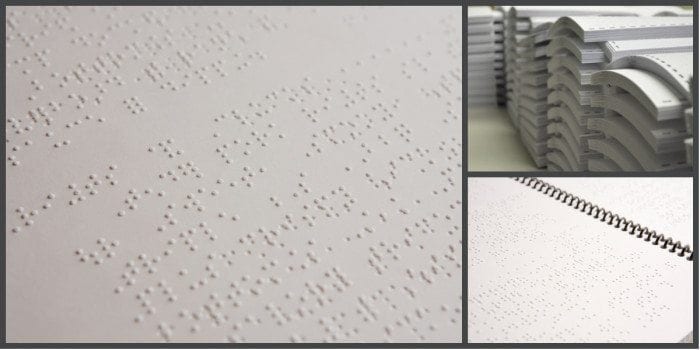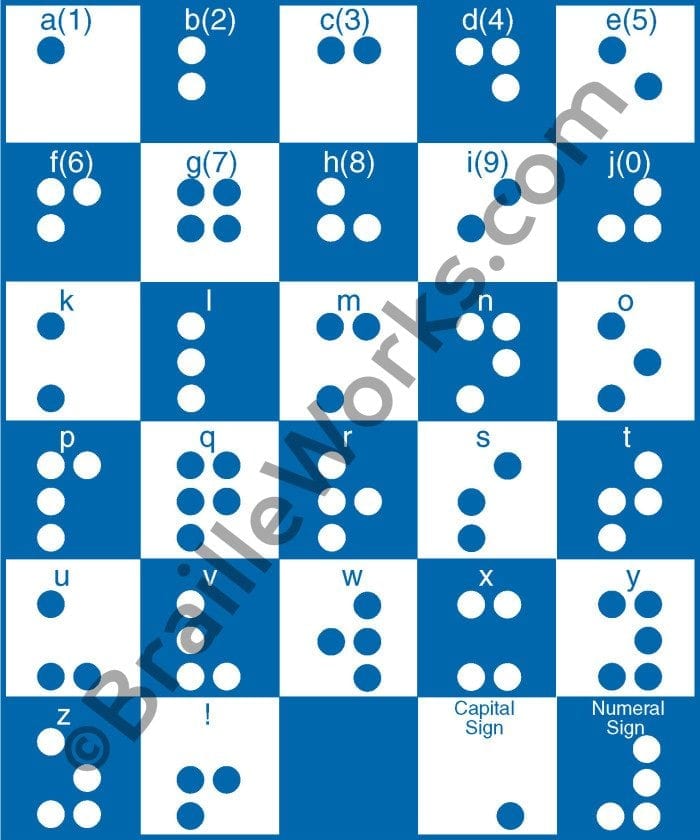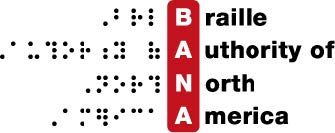What Does the Adoption of Unified English Braille Mean for You?
We began our preparation for the enactment of Unified English Braille in 2012 and are ready to implement the new code on all our Braille materials starting January 1st, 2016. [Read More]
Motion to Adopt UEB Passed by The Braille Authority of North America on November 2, 2012.
As many of you may have already heard; a majority of The Braille Authority of North America’s board members decisively passed a motion adopting Unified English Braille (UEB) in North America on November 2, 2012. The board consists of appointed representatives from braille producers, transcribers, teachers, and consumers.
The Braille Authority of North America (BANA) began the process of developing a unified code for English Braille. In 1993, the International Council on English Braille (ICEB) internationalized and took on code development. During the next decade, evaluations, seminars, and conferences took place. Both in the United States and other English-speaking countries published several articles about UEB.
The approval of UEB by BANA will set a new course for the future of Braille in the United States. Over the next few years, Unified English Braille will slowly but surely replace English Braille American Edition (EBAE). Nemeth Code for mathematics and science notation will remain unchanged.

Transitioning
The transition will follow a meticulously-crafted timeline. BANA is forming plans for implementation by tapping the input and participation of consumers, educators, rehabilitation clinics, transcriptionist, and Braille production companies. Because we use Braille in such a wide variety of ways, planning takes all the aspects of transcribing, teaching and learning Braille into consideration with the goal of minimizing the problems current Braille readers may encounter while learning UEB.
UEB is based on the current literary Braille code. Its development aims to achieve an optimal balance of many key factors. These factors include retaining the general-purpose literary code as its’ base, allowing the addition of new symbols, providing flexibility for changes as print changes, reducing the complexity of certain rules, and allowing greater accuracy in back-translation.
Although there will be changes to some punctuation, the code for letters and numbers will stay the same as they are now in the current literary code (EBAE). UEB completely eliminates nine contractions. And, some of the remaining contractions will be used more often in their place. FAQ’s with more details about the changes UEB is bringing to America are available on the BANA website.
Once the implementation process is complete, the official Braille codes for the U.S. will be UEB; Nemeth Code for mathematics and science notation, music Braille code (1997); and IPA Braille code (2008).
Find more info about UEB and the motion BANA passed at www.brailleauthority.org.
So What Does UEB Mean For You, The Braille Reader?
Impact on Individuals:
The adoption of UEB as an accepted code for use in the United States will be felt by several groups of individuals including consumers (i.e., adults and children who are blind), teachers (i.e., rehabilitation clinics and teachers of students who are visually impaired), Braille transcribers, and family members of individuals who read braille. All of these individuals will need to educate themselves on the changes UEB will bring. They’ll also need to learn the rules governing the new Braille code.
During the transition process, individuals who are familiar with English Braille American Edition (EBAE) will most likely receive at least some of their reading material embossed in UEB. This may be unsettling to readers who aren’t studied-up on UEB. However, a study conducted by researchers prior to the adoption of UEB in the United Kingdom (UK) had positive results. The results may bring some peace of mind to individuals. Nearly 40% of people who were presented with a sample text of UEB could read it without any difficulty. Similarly, in Australia and New Zealand where UEB was adopted nearly 6 years ago, 8 of 10 respondents stated they were happy their countries switched to UEB.
In general, Braille readers have responded favorably to the change. But, I’ve also heard several individuals experiencing mild-to-wild irritation about the fact they will have to re-adjust to a new Braille code. Based on their past experiences, BANA is anticipating the impact on individuals will be minimal to slightly irritating at most.

Good News
The good news is that almost all Braille translation software programs, screen readers, and note-takers have UEB already built in. There should only be a minimal impact on a Braille reader’s ability to use their electronic equipment. Some people may need to purchase software upgrades to gain access to UEB.
Here are some of the advantages of UEB for individuals according to BANA:
- More consistency, less ambiguity, and fewer exceptions to Braille rules will make Braille easier to produce and may remove some barriers people have while learning braille.
- Showing more symbols in Braille will give the Braille reader better access to the same information that is available to print readers.
- Computer translation and back-translation could be produced more quickly and with less human intervention.
- Reduce errors and ambiguity experienced by those who read contracted Braille on refreshable Braille displays. Braille displays are the equivalent of a screen on a desk-top computer or mobile device.
- Improve back-translation of Braille that’s written using electronic devices, so that Braille users can write in Braille to communicate easily and accurately with non-Braille users.
Impact on Organizations:
Organizations feel the impact of UEB adoption. Some of these include rehabilitation and educational institutions, agencies that support people with visual disabilities, and libraries. Teachers of students who are visually impaired or blind as well as vision rehabilitation therapists will find they need to learn UEB. Agencies that provide services to individuals with visual disabilities will have to adopt new training materials for their instructors as well as the students. Libraries and other organizations providing text for individuals who read Braille also must proactively think about the ways UEB might impact their service. Its anticipated Braille books produced using EBAE will continue to be available in local libraries. There will also be new books produced in UEB.
Advantages of UEB for organizations according to BANA:
- Increase the timeliness of many types of Braille production by permitting transcribers to put more focus on the advanced aspects of Braille production rather than spending time on routine matters.
- Reduce the labor required with Braille production, giving teachers more time to spend with the students instead of Brailling materials for them.
- Minimize, to some extent, difficulties experienced by a reader who is required to read computer-produced Braille that has been transcribed by someone who has not been properly trained in Braille transcription.
Impact on Production:
The adoption of UEB will also have a big impact on producers of Braille and Braille production centers, like us here at Braille Works. As a result, we will adopt the coming changes. We will transcribe in Unified English Braille as the timetable set forth by BANA warrants. The fact that several other English-speaking countries like the United Kingdom, Canada, and Australia have already adopted UEB is fantastic. This will undeniably allow the sharing of written materials among the Braille-reading populations of all these nations. Imagine how much easier it will be share knowledge with each other; it’s pretty darn exciting!
One disadvantage for the production of Unified English Braille is the code may take more space on a piece of paper than EBAE. Even so, the amount of additional space needed for literary materials should be minimal. But, the impact on technical materials can be significant depending upon the type of material needing transcription.

About BANA
The mission and purpose of The Braille Authority of North America are to assure literacy for tactile readers through the standardization of Braille and/or tactile graphics. BANA promotes and facilitates the use, teaching, and production of Braille. It publishes rules, interprets, and renders opinions pertaining to Braille in all existing codes. It also deals with codes now in existence or codes developed in the future, in collaboration with other countries using English Braille. In exercising its function and authority, BANA considers the effects of its decisions on other existing Braille codes and formats; the ease of production by various methods; and acceptability to readers.
Source:
The Braille Authority of North America (BANA)
References:
White, M. (2011a). Evaluation of the views of a sample of RNIB magazine subscribers on an Anthology of Essays produced in UEB. RNIB Braille Development Unit, Peterborough.
White, M. (2011b). The experiences of Australia and New Zealand in implementing UEB (Unified English Braille Code.) RNIB Braille Development Unit, Peterborough.
Additional Resources:
- Royal National Institute of Blind People (RNIB) – Unified English Braille
- International Council on English Braille (ICEB)


